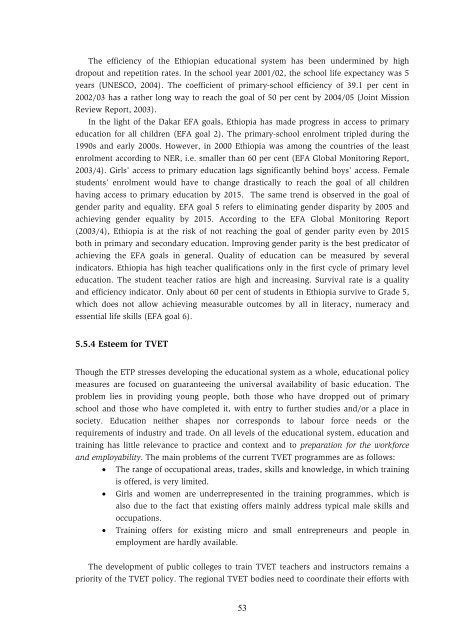Education and Training in Ethiopia An Evaluation of Approaching EFA Goals
Education and Training in Ethiopia - Koulutuksen tutkimuslaitos
Education and Training in Ethiopia - Koulutuksen tutkimuslaitos
- No tags were found...
You also want an ePaper? Increase the reach of your titles
YUMPU automatically turns print PDFs into web optimized ePapers that Google loves.
The efficiency <strong>of</strong> the <strong>Ethiopia</strong>n educational system has been underm<strong>in</strong>ed by highdropout <strong>and</strong> repetition rates. In the school year 2001/02, the school life expectancy was 5years (UNESCO, 2004). The coefficient <strong>of</strong> primary-school efficiency <strong>of</strong> 39.1 per cent <strong>in</strong>2002/03 has a rather long way to reach the goal <strong>of</strong> 50 per cent by 2004/05 (Jo<strong>in</strong>t MissionReview Report, 2003).In the light <strong>of</strong> the Dakar <strong>EFA</strong> goals, <strong>Ethiopia</strong> has made progress <strong>in</strong> access to primaryeducation for all children (<strong>EFA</strong> goal 2). The primary-school enrolment tripled dur<strong>in</strong>g the1990s <strong>and</strong> early 2000s. However, <strong>in</strong> 2000 <strong>Ethiopia</strong> was among the countries <strong>of</strong> the leastenrolment accord<strong>in</strong>g to NER, i.e. smaller than 60 per cent (<strong>EFA</strong> Global Monitor<strong>in</strong>g Report,2003/4). Girls’ access to primary education lags significantly beh<strong>in</strong>d boys’ access. Femalestudents’ enrolment would have to change drastically to reach the goal <strong>of</strong> all childrenhav<strong>in</strong>g access to primary education by 2015. The same trend is observed <strong>in</strong> the goal <strong>of</strong>gender parity <strong>and</strong> equality. <strong>EFA</strong> goal 5 refers to elim<strong>in</strong>at<strong>in</strong>g gender disparity by 2005 <strong>and</strong>achiev<strong>in</strong>g gender equality by 2015. Accord<strong>in</strong>g to the <strong>EFA</strong> Global Monitor<strong>in</strong>g Report(2003/4), <strong>Ethiopia</strong> is at the risk <strong>of</strong> not reach<strong>in</strong>g the goal <strong>of</strong> gender parity even by 2015both <strong>in</strong> primary <strong>and</strong> secondary education. Improv<strong>in</strong>g gender parity is the best predicator <strong>of</strong>achiev<strong>in</strong>g the <strong>EFA</strong> goals <strong>in</strong> general. Quality <strong>of</strong> education can be measured by several<strong>in</strong>dicators. <strong>Ethiopia</strong> has high teacher qualifications only <strong>in</strong> the first cycle <strong>of</strong> primary leveleducation. The student teacher ratios are high <strong>and</strong> <strong>in</strong>creas<strong>in</strong>g. Survival rate is a quality<strong>and</strong> efficiency <strong>in</strong>dicator. Only about 60 per cent <strong>of</strong> students <strong>in</strong> <strong>Ethiopia</strong> survive to Grade 5,which does not allow achiev<strong>in</strong>g measurable outcomes by all <strong>in</strong> literacy, numeracy <strong>and</strong>essential life skills (<strong>EFA</strong> goal 6).5.5.4 Esteem for TVETThough the ETP stresses develop<strong>in</strong>g the educational system as a whole, educational policymeasures are focused on guarantee<strong>in</strong>g the universal availability <strong>of</strong> basic education. Theproblem lies <strong>in</strong> provid<strong>in</strong>g young people, both those who have dropped out <strong>of</strong> primaryschool <strong>and</strong> those who have completed it, with entry to further studies <strong>and</strong>/or a place <strong>in</strong>society. <strong>Education</strong> neither shapes nor corresponds to labour force needs or therequirements <strong>of</strong> <strong>in</strong>dustry <strong>and</strong> trade. On all levels <strong>of</strong> the educational system, education <strong>and</strong>tra<strong>in</strong><strong>in</strong>g has little relevance to practice <strong>and</strong> context <strong>and</strong> to preparation for the workforce<strong>and</strong> employability. The ma<strong>in</strong> problems <strong>of</strong> the current TVET programmes are as follows:• The range <strong>of</strong> occupational areas, trades, skills <strong>and</strong> knowledge, <strong>in</strong> which tra<strong>in</strong><strong>in</strong>gis <strong>of</strong>fered, is very limited.• Girls <strong>and</strong> women are underrepresented <strong>in</strong> the tra<strong>in</strong><strong>in</strong>g programmes, which isalso due to the fact that exist<strong>in</strong>g <strong>of</strong>fers ma<strong>in</strong>ly address typical male skills <strong>and</strong>occupations.• <strong>Tra<strong>in</strong><strong>in</strong>g</strong> <strong>of</strong>fers for exist<strong>in</strong>g micro <strong>and</strong> small entrepreneurs <strong>and</strong> people <strong>in</strong>employment are hardly available.The development <strong>of</strong> public colleges to tra<strong>in</strong> TVET teachers <strong>and</strong> <strong>in</strong>structors rema<strong>in</strong>s apriority <strong>of</strong> the TVET policy. The regional TVET bodies need to coord<strong>in</strong>ate their efforts with53




![to read the full report [pdf, Amharic] - Ethiopian Review](https://img.yumpu.com/52737829/1/190x245/to-read-the-full-report-pdf-amharic-ethiopian-review.jpg?quality=85)











